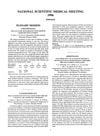Radiation-Induced Microvascular Injury as a Mechanism of Salivary Gland Hypofunction and Potential Target for Radioprotectors
July 2016
in “
Radiation Research
”
TLDR Radiation damages salivary glands by harming blood vessels, but antioxidants might help protect them.
The study investigated how radiation-induced microvascular injury contributed to salivary gland hypofunction, a common side effect in head and neck cancer patients undergoing radiotherapy. Using bovine aortic endothelial cells and mice, researchers found that radiation caused endothelial apoptosis and increased ceramide production, both mediated by reactive oxygen species (ROS). ROS scavengers like Tempol and NAC significantly reduced these effects, preserving microvessel density and partially restoring salivary flow. However, Tempol did not prevent the decrease in saliva quality. The findings suggested that targeting ROS-mediated ceramide generation could protect salivary gland function during radiotherapy. The study involved 12 glands from six mice per treatment group.



